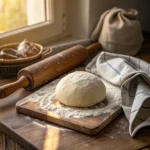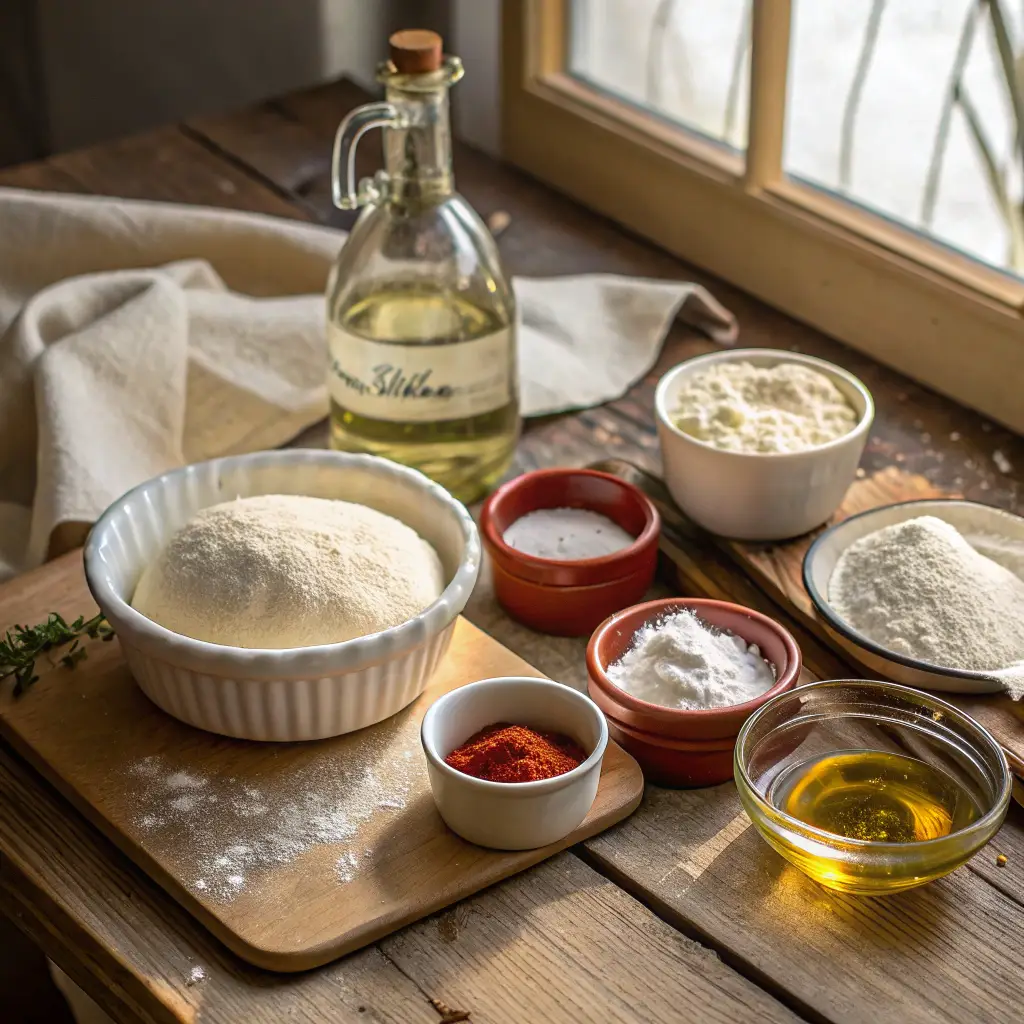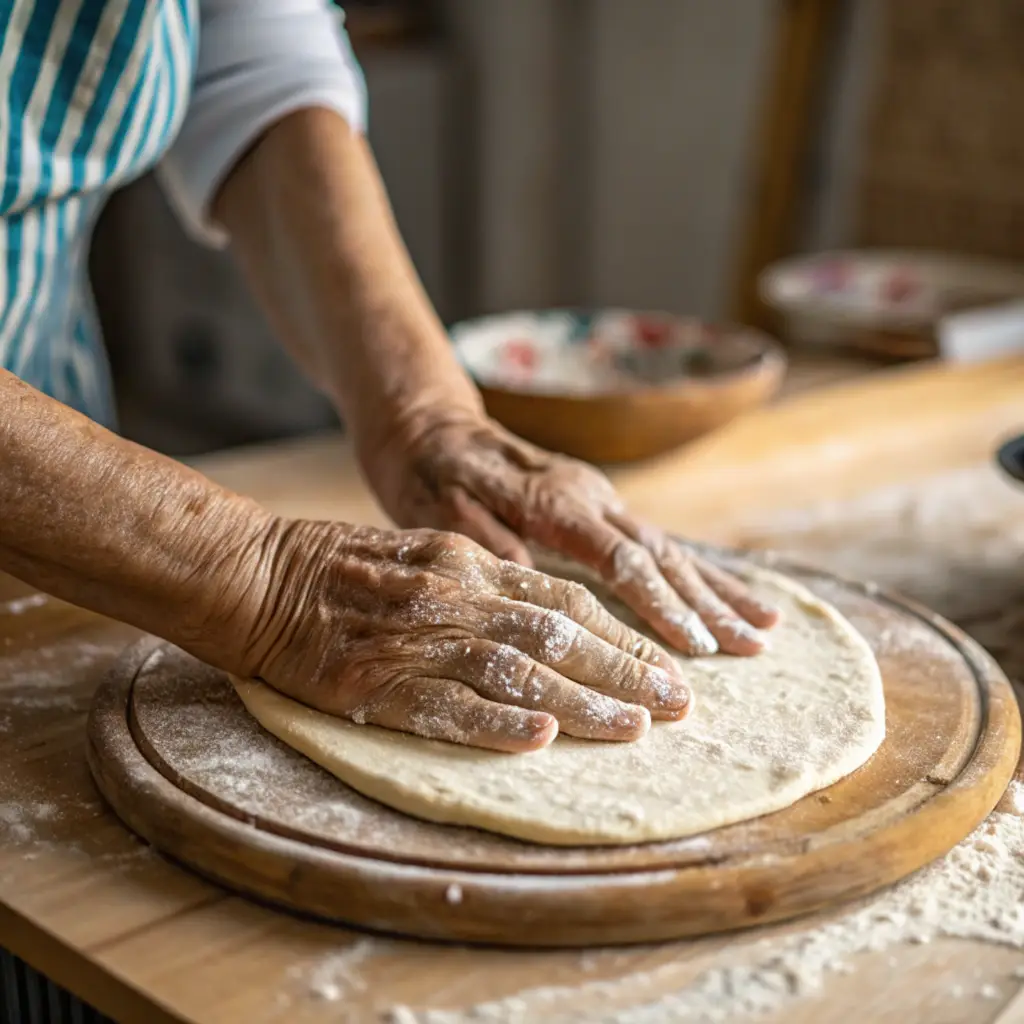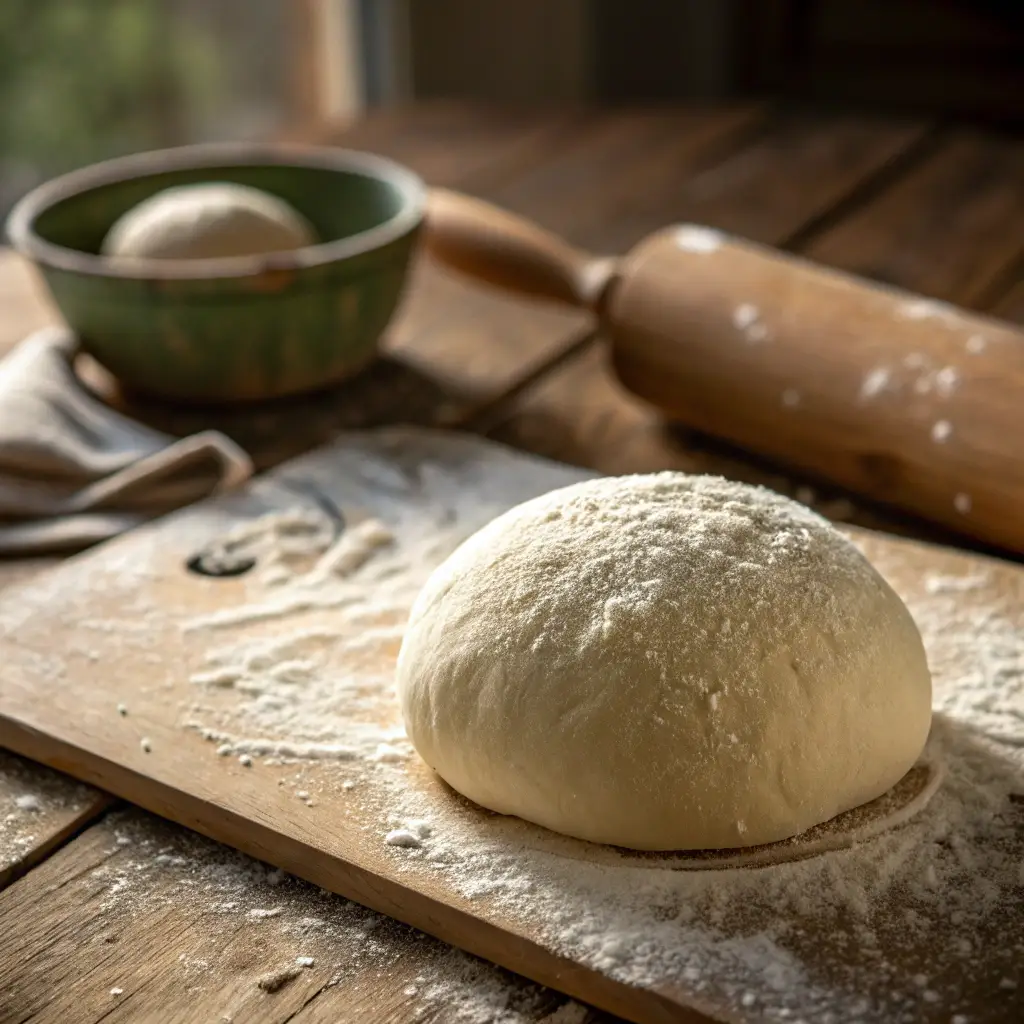Pizza dough was something we didn’t talk much about we just made it. You’d know it was pizza day when mamma poured flour onto the table and said, “Lucia, wash your hands.”
She’d mix by feel. Warm water, salt, a bit of oil. The whole house smelled like yeast and home. I’d press my fingers into the dough while it rested, and she’d pretend not to see.
When I moved here, I tried store pizza dough once. It baked, surebut it had no soul. No memory.
So I started again. Like she did. Slowly. With care.
This pizza dough is the same one I make for my grandchildren now. It’s soft, simple, full of flavor. I’ll walk you through every step so you can make it yours too.
Table of Contents
Table of Contents

Guide to Pizza Dough Unlock The Secret to Perfect Pizza
- Total Time: 1 to 3 hours (plus optional 1–3 days cold proof)
- Yield: 2–3 pizzas 1x
Description
This pizza dough is soft, simple, and full of flavor. A real family recipe from Nonna Lucia, made for sharing.
Ingredients
500 g (about 4 cups) 00 flour or bread flour
350 g (about 1 ½ cups) lukewarm water
1 tsp active dry yeast or ½ tsp instant yeast
2 tsp fine sea salt
1 tbsp extra virgin olive oil
A pinch of sugar (optional)
Instructions
1. Pour the warm water into a small bowl. Sprinkle yeast on top and add a pinch of sugar. Stir and let sit about 10 minutes, until foamy. Skip this if using instant yeast.
2. In a big bowl, mix the flour and salt.
3. Add the bloomed yeast (or water and instant yeast) and olive oil to the flour. Mix by hand or with a spoon until a shaggy dough forms.
4. Knead by hand on a floured surface for 8–10 minutes, or with a mixer for 6–8 minutes, until soft and stretchy.
5. Place dough in an oiled bowl. Cover and let rise in a warm spot until doubled, about 1–2 hours.
6. Gently press air from dough. Divide into 2 or 3 pieces. Shape each into a ball. Place on a floured surface.
7. (Optional) Cover and refrigerate dough balls for 1–3 days for best flavor.
8. Bring dough to room temperature 1–2 hours before shaping. Stretch, top, and bake as you like.
Notes
If your kitchen is cold, let dough rise in the oven with just the light on.
A scale makes measuring flour and water easy and accurate.
Mix in a little whole wheat or semolina flour for a different flavor.
Be patient. Letting the dough rest is key for the best texture and taste.
- Prep Time: 15 minutes
- Cook Time: 10 minutes
- Category: Traditional Pizza Recipes
- Method: Baking
- Cuisine: Italian
Keywords: pizza dough, Italian pizza dough, homemade pizza, Nonna Lucia, traditional pizza
Why You’ll Love This Recipe
This pizza dough is the kind we made at home. Nothing fancy. Just good, honest dough that works.
- Amazingly Flavorful
Resting the dough brings out a deep, old-world flavor. - Perfectly Textured
Light inside, crisp underneath. Folds just right in your hand. - Surprisingly Simple
You don’t need much. A bowl, flour, and time. - Totally Customizable
Make it thick, thin, soft, or crispy. It holds anything you like.
I’ve made this dough more times than I can count. It never disappoints.
Ingredients Needed

You don’t need much to make good pizza dough. Just simple ingredients and a little patience.
For the Dough
- 500 g (about 4 cups) of 00 flour or bread flour
(00 flour makes it soft and light. Bread flour gives it more chew.) - 350 g (about 1½ cups) lukewarm water
(Not hot. Just warm to the touch. It wakes up the yeast.) - 1 tsp active dry yeast or ½ tsp instant yeast
(Use what you have. If it’s active dry, you’ll bloom it first.) - 2 tsp fine sea salt
(Don’t use regular table salt. It can be too sharp.) - 1 tbsp extra virgin olive oil
(This helps with stretch and adds a little richness.)
Optional
- A pinch of sugar
(If your kitchen is cool, this helps feed the yeast at the start.)
How to Make Your Perfect Pizza Dough

This is how we made pizza dough in my family. Slowly, with care, and never in a rush. Every step matters, and I’ll walk you through it.
1. Bloom the Yeast (only for active dry yeast)
Pour the warm water into a small bowl and sprinkle the yeast on top. Add a tiny pinch of sugar and stir. Let it sit for about 10 minutes. If it gets foamy, your yeast is alive and ready.
Skip this part if you are using instant yeast.
2. Mix the Dry Ingredients
In a big bowl, stir together the flour and salt. This makes sure the salt won’t touch the yeast too soon, which can stop it from working.
3. Combine Everything
Add the bloomed yeast and olive oil to the flour. If using instant yeast, mix it straight into the flour before adding the water and oil. Use your hands or a wooden spoon to bring the dough together. It will be a bit sticky at first. That’s good.
4. Knead the Pizza Dough
Knead by hand on a floured surface for 8 to 10 minutes. Or use a mixer with a dough hook on low speed for 6 to 8 minutes. You want it to feel smooth, soft, and stretchy.
Try the windowpane test: pinch off a bit of dough and stretch it gently. If you can see light through it without tearing, it’s ready.
5. Let It Rise (First Fermentation)
Place the dough in a clean bowl with a little olive oil. Cover it with a towel and let it rise in a warm, quiet place for 1 to 2 hours. It should double in size.
This is when your pizza dough starts to build flavor and air inside.
6. Divide and Shape
Gently press out the air. Cut the dough into 2 or 3 pieces. Shape each one into a tight ball by folding the sides underneath and rolling gently. Place them on a floured board.
7. Rest in the Fridge (Second Fermentation, optional)
If you have time, cover the dough balls and put them in the fridge for one to three days. This long, cold rest makes the pizza dough taste even better and gives it lovely texture.
8. Get Ready to Bake
Take the dough out of the fridge about 2 hours before baking. Let it warm up and relax. Cold pizza dough is hard to stretch and won’t bake properly.
Serving and Storage Tips

This pizza dough works for any style you like. Use it for a thin, crisp base or a thick, soft crust. I like it best on a hot stone, but any oven tray will do.
After you shape the dough into balls, you can keep them in the fridge for three days. Before you bake, let them warm up on the counter. Cold dough is hard to shape and bakes up tough.
You can freeze extra dough. Wrap each ball tight and put them in a freezer bag. When you need it, thaw in the fridge and let it rest at room temperature before baking.
00 Flour vs. Bread Flour
In Italy, we always used 00 flour for pizza dough. It was everywhere, in the air and on our aprons. The dough felt soft and stretched easy. The pizza came out light with a soft middle.
Here, I grab bread flour when that’s all I have. It’s stronger. The dough is tighter and the crust comes out chewy and thick. Sometimes I use both, sometimes just one. To me, the best pizza dough is the one you make for the people you love. The flour is just the start.
Helpful Notes
If my kitchen is cold, I put the bowl with pizza dough in the oven and switch on the oven light. That’s what my mamma always did. The dough rises best when it’s cozy.
I like using a kitchen scale, even though I learned by eye. It makes the pizza dough turn out the same every time, no surprises.
Sticky dough just needs a dusting of flour on my hands. If it’s too dry, I wet my fingers and knead a little more, the way I always have.
Sometimes I toss in a handful of semolina or whole wheat, just to see what happens. It wasn’t our tradition, but it gives a different flavor.
Pizza dough takes its time. I always say, don’t rush it. Let it rest and you’ll get a better crust. That’s the truth from my kitchen.
FAQs
Can I make pizza dough without yeast?
Yes, it’s possible to make a quick pizza dough with baking powder or self-rising flour instead of yeast, but the flavor and texture will be different. Yeast gives pizza dough its classic rise and flavor.
Can I use gluten-free flour for pizza dough?
Yes, there are gluten-free flour blends you can use to make pizza dough. The method and texture will be different, and you may need to add a binding ingredient like xanthan gum for best results.
Do I need sugar in my pizza dough?
Sugar is optional. It helps feed the yeast, especially if your kitchen is cold, but pizza dough can rise and taste great without it.
How do I prevent pizza dough from sticking to my hands or the counter?
Keep your hands and surface lightly floured. You can also rub a little oil on your hands when working with sticky dough.
Can I par-bake or pre-bake my pizza dough?
Yes, you can bake the rolled-out dough for a few minutes before adding toppings. This helps if you want a crispier base or are adding heavy toppings.
Can I make pizza dough ahead and let it rise overnight at room temperature?
It’s best to refrigerate dough for long rises, but if your kitchen is cool, you can let it rise at room temperature overnight. Keep it covered to avoid drying out.
What is the best way to reheat leftover pizza dough or baked pizza?
For baked pizza, reheat in a hot oven or on a skillet for a crispy bottom. For leftover dough, let it come to room temperature before using, or gently warm it to make it easier to shape.
Can I use olive oil in the dough and on top before baking?
Yes, a little olive oil in the dough helps with flavor and texture, and brushing some on the crust before baking gives it a golden color and extra taste.
Conclusion
When I make pizza dough, I think of the old kitchen back home. My mamma’s hands, flour in the air, everyone waiting for that first slice. Simple times, but special.
You can use this pizza dough for so many things. Try it with authentic Italian pizza, or look at my pizza dough tips if you want to go deeper. Sometimes I spoon on hot honey sauce for something new.
Let me know if you try this. Tag us on Facebook or Pinterest. I hope your kitchen fills with good smells, good food, and the people you love. That’s what pizza dough is for.
- Easy Mini Pizza Recipe That Will Steal the Show at Any Gathering - September 18, 2025
- Homemade BBQ Chicken Pizza: A Sensational Twist on a Time-Honored Favorite - September 15, 2025
- Easy Margherita Pizza: A Sensational Slice of Old-World Comfort - September 13, 2025



